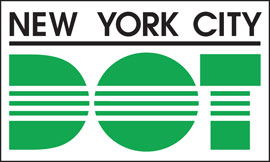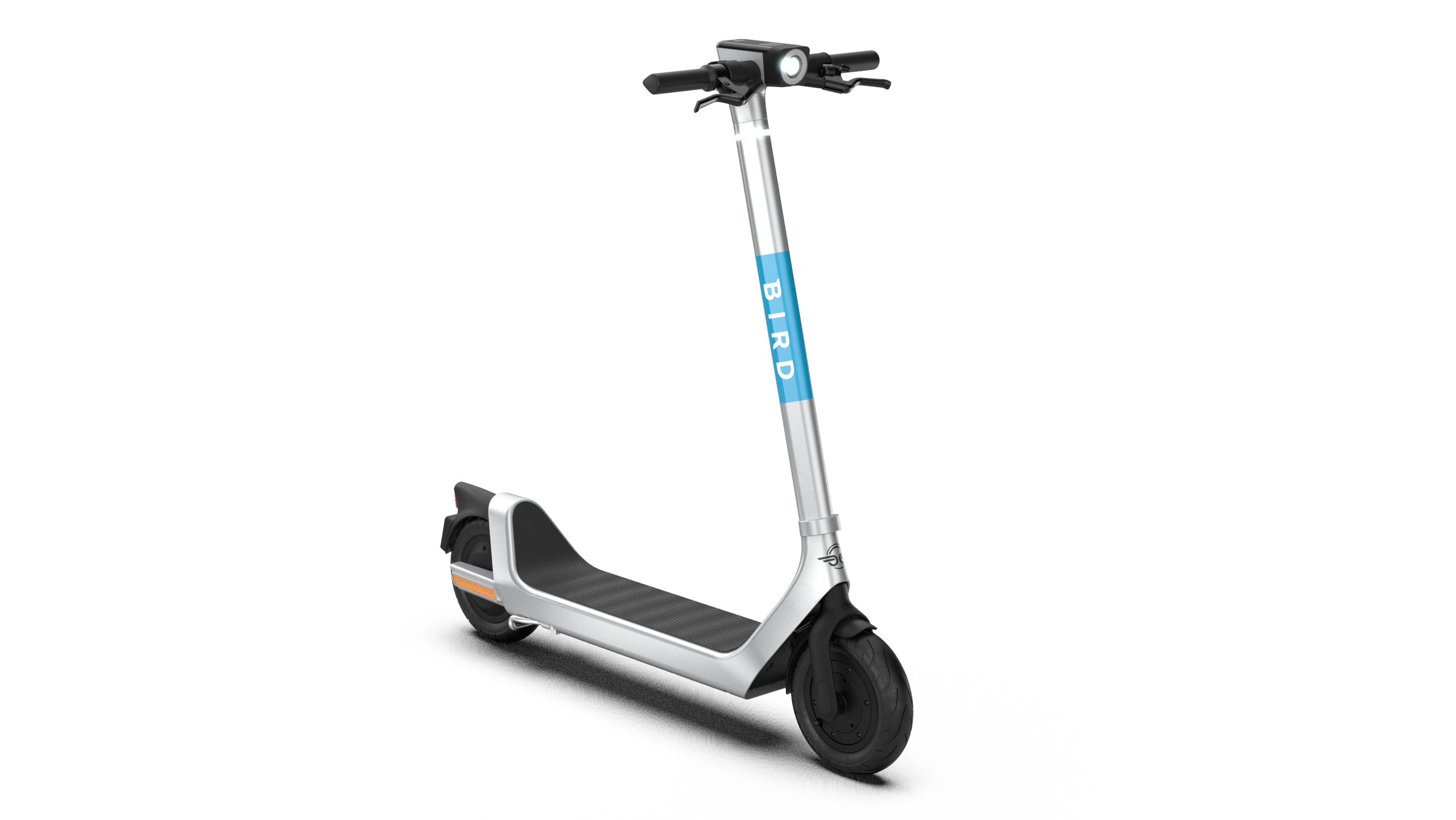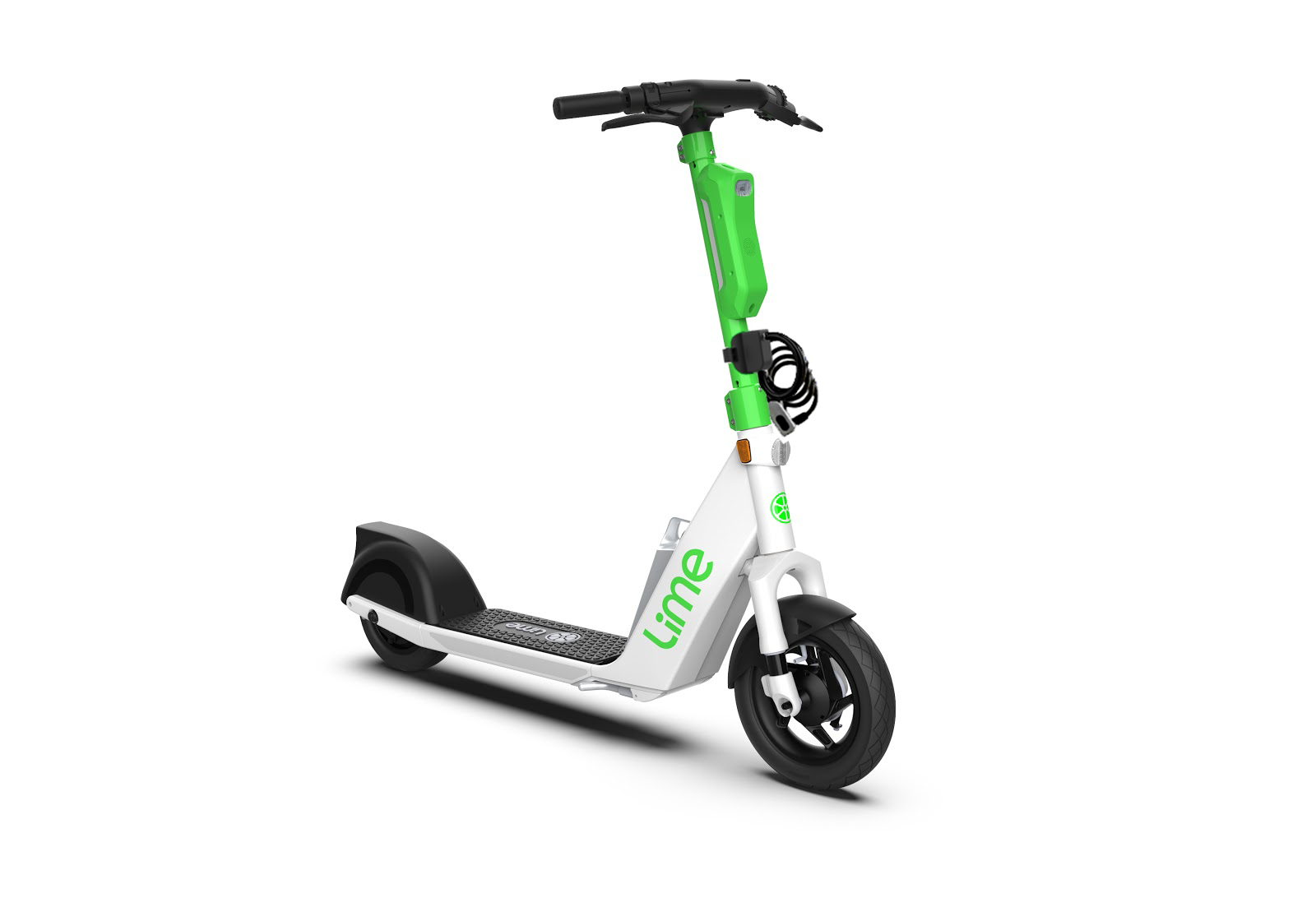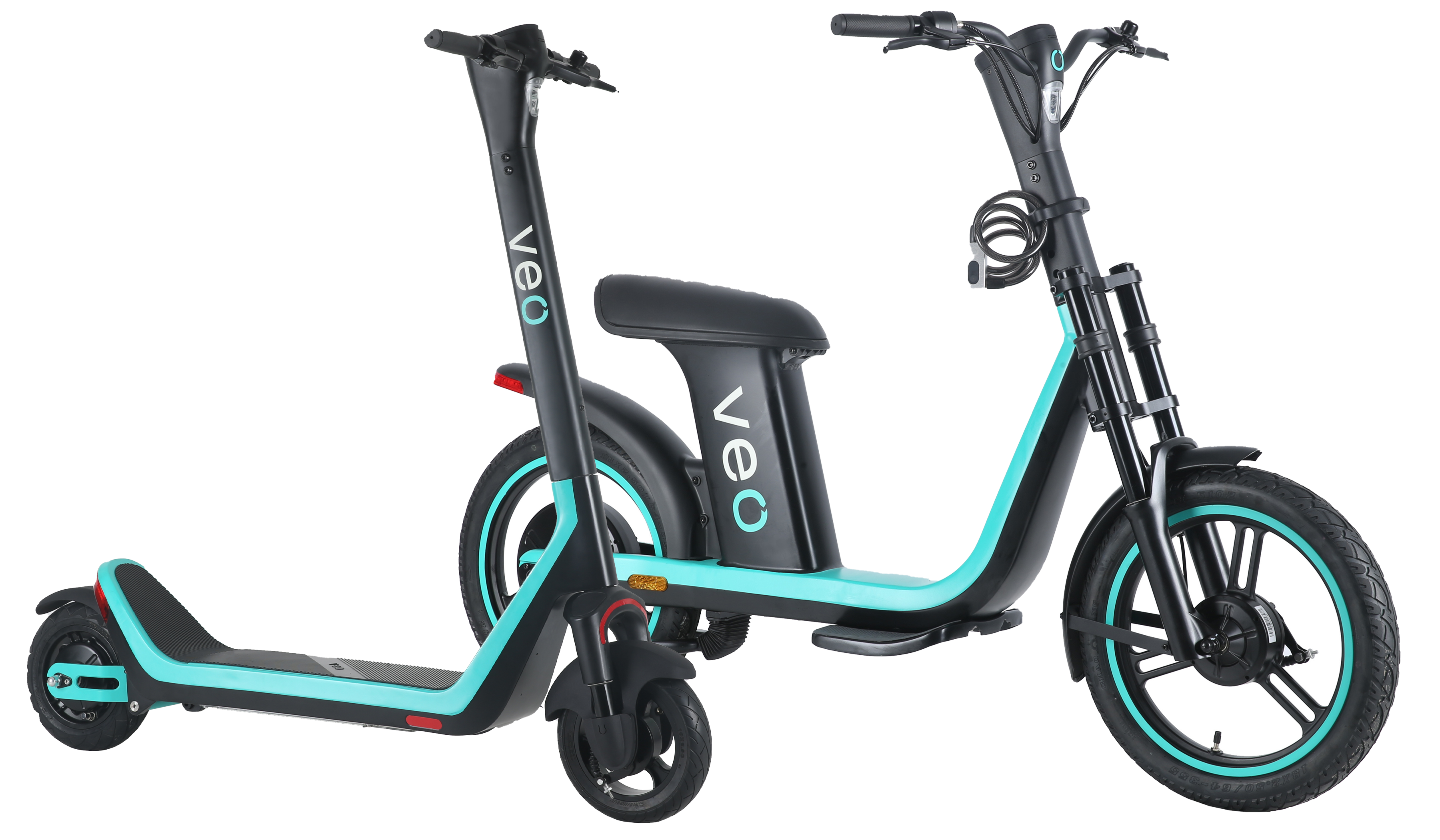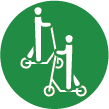
What is an e-scooter?
Electric scooters, also known as e-scooters, have handlebars and a floorboard or seat and may be powered by electric and/or human power. The citywide speed limit for e-scooters is 15 MPH. New Yorkers must be 16 years or older to ride a privately owned e-scooter. To use a shared e-scooter, New Yorkers must be 18 or older.
For differences between e-mobility devices, please see this chart (PDF).
E-scooters should be operated and treated in the same way as bicycles. E-scooter users are permitted to ride in bike lanes and on streets with speed limits no greater than 30 MPH. E-scooter users may not ride on the sidewalk and must obey all local traffic laws. For more information, please check out the rules of the road (PDF). Riders who are 16 or 17 years old must wear a helmet when riding an e-scooter. However, all riders are encouraged to wear a helmet, regardless of age.

What is an e-scooter?
Electric scooters, also known as e-scooters, have handlebars and a floorboard or seat and may be powered by electric and/or human power. The citywide speed limit for e-scooters is 15 MPH. New Yorkers must be 16 years or older to ride a privately owned e-scooter. To use a shared e-scooter, New Yorkers must be 18 or older.
For differences between e-mobility devices, please see this chart (PDF).
E-scooters should be operated and treated in the same way as bicycles. E-scooter users are permitted to ride in bike lanes and on streets with speed limits no greater than 30 MPH. E-scooter users may not ride on the sidewalk and must obey all local traffic laws. For more information, please check out the rules of the road (PDF). Riders who are 16 or 17 years old must wear a helmet when riding an e-scooter. However, all riders are encouraged to wear a helmet, regardless of age.

What is e-scooter share?
Shared e-scooter systems have become popular in many American cities in recent years, allowing millions of people to rent publicly accessible e-scooters for short trips. Riders find and unlock shared e-scooters within a designated service area using a smartphone app.
What is the history of e-scooter share in New York City?
In 2020, the New York City Council passed Local Law 74 (PDF), mandating that the New York City Department of Transportation (NYC DOT) conduct a pilot for an e-scooter share system in New York City. The law specified that the pilot would not occur in Manhattan and would prioritize areas underserved by Citi Bike. The pilot ran in the East Bronx between August 2021 - August 2023.
Throughout the pilot, NYC DOT evaluated shared e-scooters as a viable transportation option in New York City and monitored the scooter operators' ability to provide a safe, affordable, and well-maintained transportation option. Due to the pilot's success, NYC DOT and the e-scooter operators transitioned from a pilot to a long-term program that runs until 2029.
Where is e-scooter share available in New York City?
Scooters are available in East Bronx neighborhoods from Eastchester and Co-Op City to Throggs Neck and Soundview, a 22-square mile area home to 590,000 residents and several major employment centers, including Jacobi and Montefiore Hospitals and the Soundview Ferry terminal.
In 2024, the program expanded to Eastern Queens. The program covers a 23-square mile area, from Flushing and Auburndale in the north to Rochdale Village and Springfield Gardens in the south, home to 600,000 residents, four universities, and several popular commercial corridors.
E-scooter share rides must begin and end in the service area. If a user tries to ride an e-scooter out of the service area, the motor will power down but the user will still be charged until returning to the service area. Maps of the service areas are attached below.
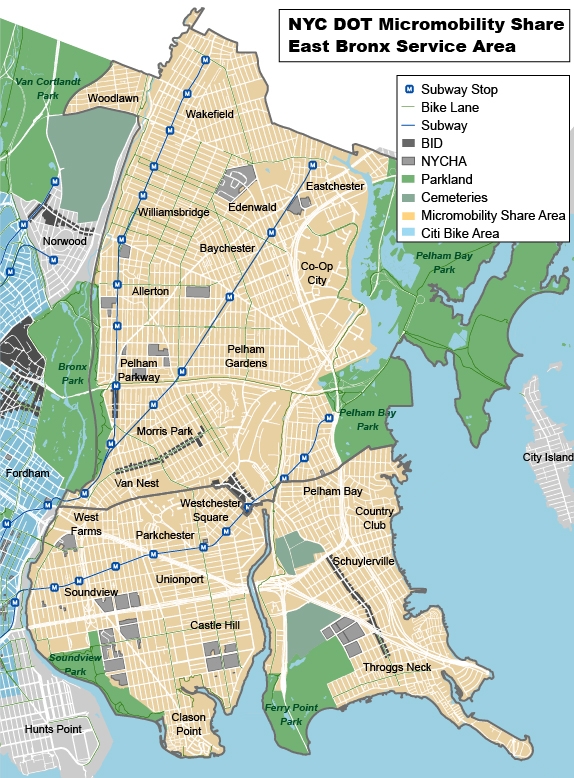
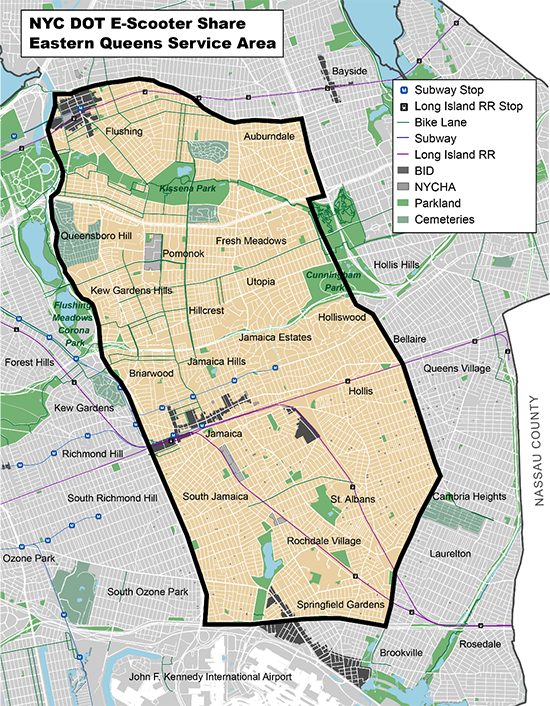
What e-scooter share companies are participating?
Three operators, Bird, Lime, and Veo, are participating in the current program. All operators currently serve the East Bronx and Eastern Queens. Though the number of shared e-scooters on the street varies based on season, the maximum total e-scooter share fleet is 5,500 in the East Bronx and 6,000 in Eastern Queens.

What is e-scooter share?
Shared e-scooter systems have become popular in many American cities in recent years, allowing millions of people to rent publicly accessible e-scooters for short trips. Riders find and unlock shared e-scooters within a designated service area using a smartphone app.
What is the history of e-scooter share in New York City?
In 2020, the New York City Council passed Local Law 74 (PDF), mandating that the New York City Department of Transportation (NYC DOT) conduct a pilot for an e-scooter share system in New York City. The law specified that the pilot would not occur in Manhattan and would prioritize areas underserved by Citi Bike. The pilot ran in the East Bronx between August 2021 - August 2023.
Throughout the pilot, NYC DOT evaluated shared e-scooters as a viable transportation option in New York City and monitored the scooter operators' ability to provide a safe, affordable, and well-maintained transportation option. Due to the pilot's success, NYC DOT and the e-scooter operators transitioned from a pilot to a long-term program that runs until 2029.
Where is e-scooter share available in New York City?
Scooters are available in East Bronx neighborhoods from Eastchester and Co-Op City to Throggs Neck and Soundview, a 22-square mile area home to 590,000 residents and several major employment centers, including Jacobi and Montefiore Hospitals and the Soundview Ferry terminal.
In 2024, the program expanded to Eastern Queens. The program covers a 23-square mile area, from Flushing and Auburndale in the north to Rochdale Village and Springfield Gardens in the south, home to 600,000 residents, four universities, and several popular commercial corridors.
E-scooter share rides must begin and end in the service area. If a user tries to ride an e-scooter out of the service area, the motor will power down but the user will still be charged until returning to the service area. Maps of the service areas are attached below.


What e-scooter share companies are participating?
Three operators, Bird, Lime, and Veo, are participating in the current program. All operators currently serve the East Bronx and Eastern Queens. Though the number of shared e-scooters on the street varies based on season, the maximum total e-scooter share fleet is 5,500 in the East Bronx and 6,000 in Eastern Queens.
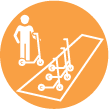
Where are shared e-scooters allowed to park?
Parking rules for shared e-scooters vary based on location within the service area. There are two types of parking; free floating parking and mandatory corral zones.
- Free-Floating Zone: Users must park their e-scooters on the sidewalk in the furniture zone. The furniture zone is the area closest to the roadway where you see trees, parking signs, bike racks, and other street furniture.
- Mandatory Corral Zone: Users must park the e-scooter inside a designated parking corral in order to end their trip.
Please see our live map of free-floating and mandatory corral zones in our "Presentations & Maps" tab. Static PDF maps are also available for East Bronx or Eastern Queens.
What is “free floating” parking and where is it located?
"Free floating" parking areas, which make up the vast majority of the service area, are where riders can park their shared e-scooter in the furniture zone of the sidewalk.
The furniture zone of a sidewalk is the area at the edge of the sidewalk, adjacent to the roadbed, where the public typically finds benches, bus stops, tree pits, and parking signs. When parking in the furniture zone, users must not:
- block the pedestrian path of travel, including pedestrian ramps
- block curb cuts or driveways
- park on private property or the roadbed
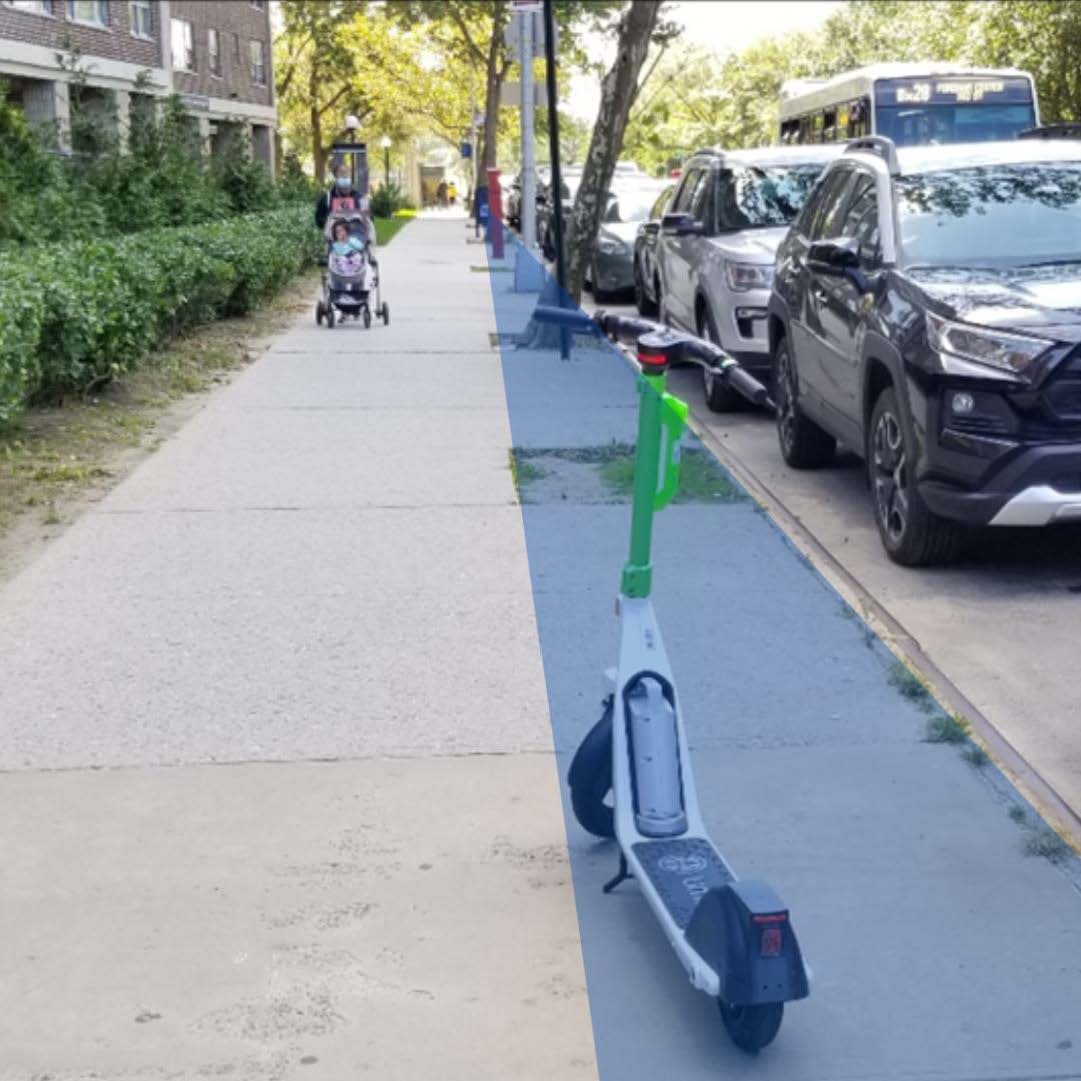
What are “mandatory corral zones” and where are they located?
“Mandatory corral zones” are areas within the service area where users must park their shared e-scooter in a designated parking corral in order to end their trip. These are especially useful in dense, commercial corridors to minimize sidewalk clutter and allow the system to act more like docked scooter share.
Parking corrals are painted boxes located on the sidewalk or in the roadbed. Residents can suggest where parking corrals should be located on our feedback portal maps. For more information regarding the locations of corrals, please visit the "Maps & Plans" tab at in the top menu.
E-scooter share companies are required to maintain the parking corrals. To report maintenance issues at a shared e-scooter corral, please email scooter.share@dot.nyc.gov.
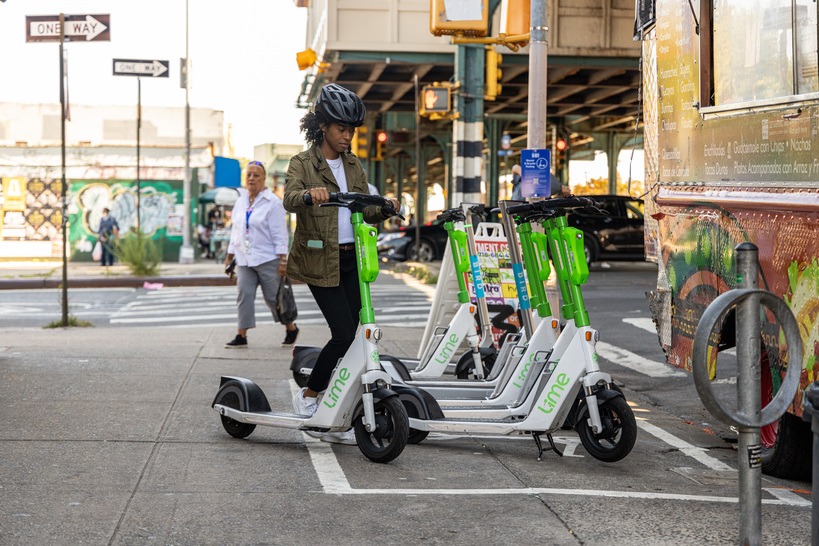
Can additional “mandatory corral zones” be added?
Additional parking corrals may be sited and installed as the program continues. NYC DOT is also accepting feedback on where people would like to see parking corrals. Please visit the "Suggest Scooter Parking" tab in the top menu to suggest additional parking corrals in the Bronx and Queens.
How can I report improperly parked shared e-scooters?
E-scooter share companies are required to respond to improperly parked vehicles quickly. Community members can alert shared e-scooter companies of improperly parked shared e-scooters by calling the customer service phone number on the vehicle, using the company’s Community Reporting Tool in the app or on their website, or calling 311.
Please visit the "Contact" section below for each e-scooter share company's contact information.

Where are shared e-scooters allowed to park?
Parking rules for shared e-scooters vary based on location within the service area. There are two types of parking; free floating parking and mandatory corral zones.
- Free-Floating Zone: Users must park their e-scooters on the sidewalk in the furniture zone. The furniture zone is the area closest to the roadway where you see trees, parking signs, bike racks, and other street furniture.
- Mandatory Corral Zone: Users must park the e-scooter inside a designated parking corral in order to end their trip.
Please see our live map of free-floating and mandatory corral zones in our "Presentations & Maps" tab. Static PDF maps are also available for East Bronx or Eastern Queens.
What is “free floating” parking and where is it located?
"Free floating" parking areas, which make up the vast majority of the service area, are where riders can park their shared e-scooter in the furniture zone of the sidewalk.
The furniture zone of a sidewalk is the area at the edge of the sidewalk, adjacent to the roadbed, where the public typically finds benches, bus stops, tree pits, and parking signs. When parking in the furniture zone, users must not:
- block the pedestrian path of travel, including pedestrian ramps
- block curb cuts or driveways
- park on private property or the roadbed

What are “mandatory corral zones” and where are they located?
“Mandatory corral zones” are areas within the service area where users must park their shared e-scooter in a designated parking corral in order to end their trip. These are especially useful in dense, commercial corridors to minimize sidewalk clutter and allow the system to act more like docked scooter share.
Parking corrals are painted boxes located on the sidewalk or in the roadbed. Residents can suggest where parking corrals should be located on our feedback portal maps. For more information regarding the locations of corrals, please visit the "Maps & Plans" tab at in the top menu.
E-scooter share companies are required to maintain the parking corrals. To report maintenance issues at a shared e-scooter corral, please email scooter.share@dot.nyc.gov.

Can additional “mandatory corral zones” be added?
Additional parking corrals may be sited and installed as the program continues. NYC DOT is also accepting feedback on where people would like to see parking corrals. Please visit the "Suggest Scooter Parking" tab in the top menu to suggest additional parking corrals in the Bronx and Queens.
How can I report improperly parked shared e-scooters?
E-scooter share companies are required to respond to improperly parked vehicles quickly. Community members can alert shared e-scooter companies of improperly parked shared e-scooters by calling the customer service phone number on the vehicle, using the company’s Community Reporting Tool in the app or on their website, or calling 311.
Please visit the "Contact" section below for each e-scooter share company's contact information.

What safety measures are in place for the e-scooter share program?
Safety for all road users is NYC DOT’s number one priority. Shared e-scooter companies must adhere to several safety requirements that align with New York City’s Vision Zero policy. Safety requirements include:
- New users must complete an in-app safety training and pass a safety quiz
- New users must complete ‘Beginner Mode’ wherein the first 3 trips are a slower speed and cannot occur overnight.
- Companies must establish a helmet giveaway and/or discount program
- Companies must hold free, voluntary in-person lessons
- Companies must create rider accountability policies to discourage poor rider behavior
- Companies must create policies to prevent account sharing
Will accessible vehicles be available to New Yorkers with disabilities?
As part of their contract, each company must provide wheelchair accessible vehicles. These vehicles will be available for longer rentals and delivered to a user’s home or picked up at partner organization site. Please contact the e-scooter company directly for more information.
Learn about Bird's Adaptive Program
Can e-scooter share companies use contract workers?
No, companies are not permitted to use gig workers for any part of the e-scooter share program. All work conducted in relation to the e-scooter share program must be conducted by W-2 employees. No fleet franchise models will be allowed. NYC DOT will encourage companies to hire New York City residents for roles created to support the program.

What safety measures are in place for the e-scooter share program?
Safety for all road users is NYC DOT’s number one priority. Shared e-scooter companies must adhere to several safety requirements that align with New York City’s Vision Zero policy. Safety requirements include:
- New users must complete an in-app safety training and pass a safety quiz
- New users must complete ‘Beginner Mode’ wherein the first 3 trips are a slower speed and cannot occur overnight.
- Companies must establish a helmet giveaway and/or discount program
- Companies must hold free, voluntary in-person lessons
- Companies must create rider accountability policies to discourage poor rider behavior
- Companies must create policies to prevent account sharing
Will accessible vehicles be available to New Yorkers with disabilities?
As part of their contract, each company must provide wheelchair accessible vehicles. These vehicles will be available for longer rentals and delivered to a user’s home or picked up at partner organization site. Please contact the e-scooter company directly for more information.
Learn about Bird's Adaptive Program
Can e-scooter share companies use contract workers?
No, companies are not permitted to use gig workers for any part of the e-scooter share program. All work conducted in relation to the e-scooter share program must be conducted by W-2 employees. No fleet franchise models will be allowed. NYC DOT will encourage companies to hire New York City residents for roles created to support the program.

For general comments, questions, and concerns regarding the shared e-scooter program please contact NYC DOT directly at:
- Email: scooter.share@dot.nyc.gov
- Call: NYC DOT Bronx Borough Commissioner – (212) 748-6680
- Call: NYC DOT Queens Borough Commissioner – (212) 839-2510
For specific issues regarding accounts, operations, or improperly parked vehicles, please contact the specific shared e-scooter company directly.
Bird Contact Info
Lime Contact Info
Veo Contact Info

For general comments, questions, and concerns regarding the shared e-scooter program please contact NYC DOT directly at:
- Email: scooter.share@dot.nyc.gov
- Call: NYC DOT Bronx Borough Commissioner – (212) 748-6680
- Call: NYC DOT Queens Borough Commissioner – (212) 839-2510
For specific issues regarding accounts, operations, or improperly parked vehicles, please contact the specific shared e-scooter company directly.
